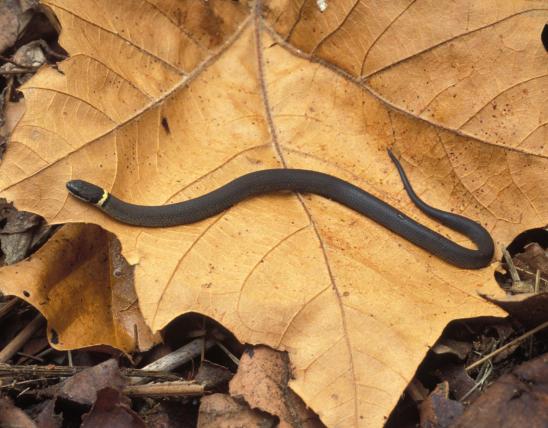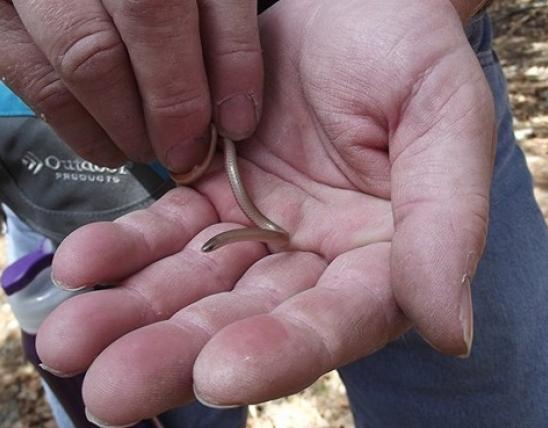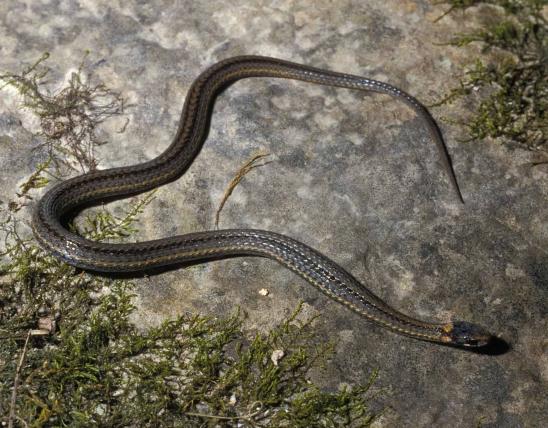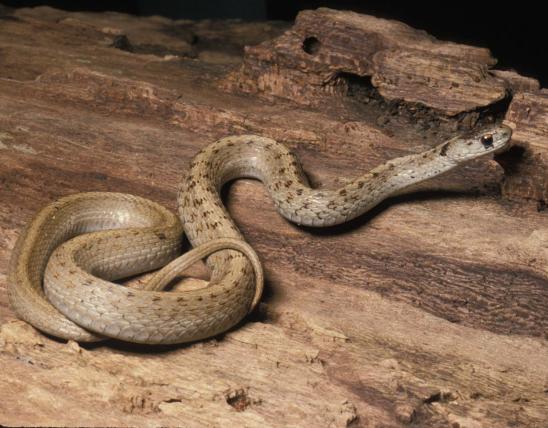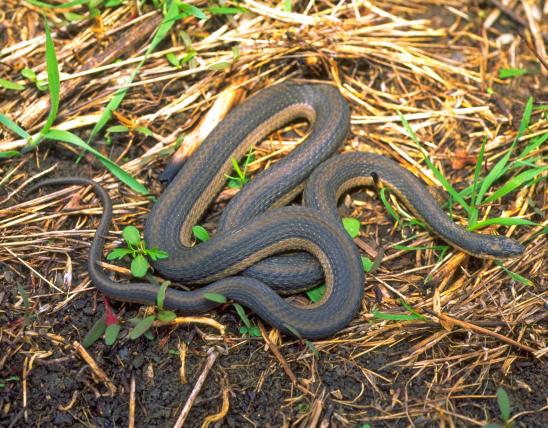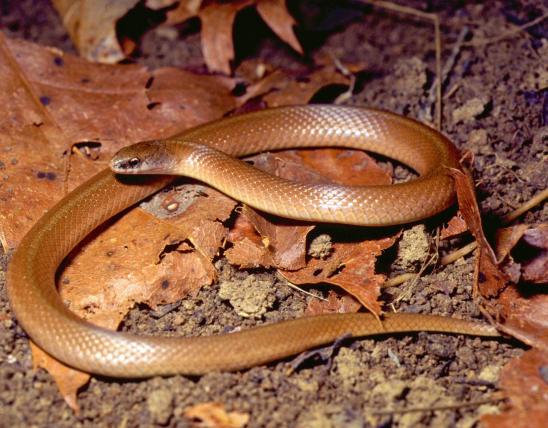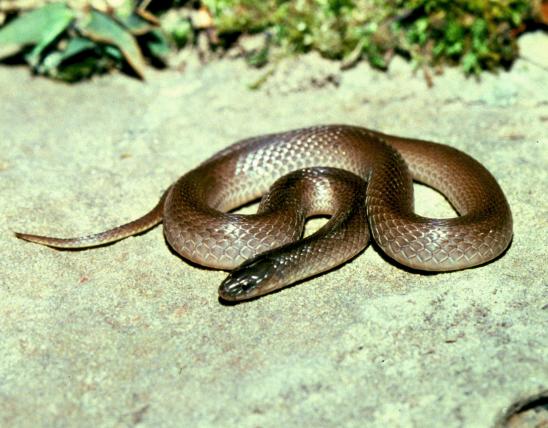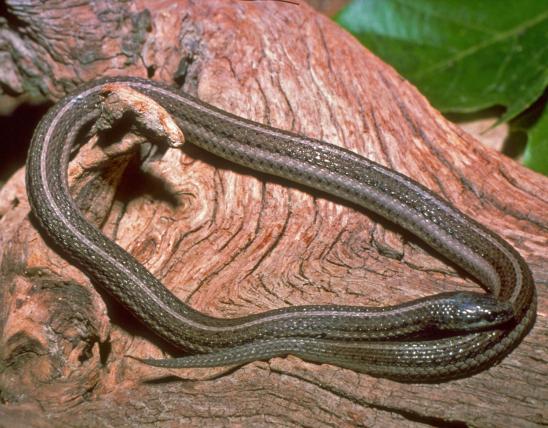
Kirtland’s snake is a small to medium-sized snake with numerous black or dark-brown blotches. The dorsal (upperside) ground color is reddish brown to grayish brown with 2 rows of round dark spots extending along the back, and a row of round dark spots running along each side. Taken together, these 4 rows of alternating dark spots create a somewhat checkerboard pattern if viewed from above. The head is black or brown with a cream to yellow chin and throat. A key identifying characteristic is the belly, which is pink to red, with dark stippling along each side. The dorsal scales are keeled, and the anal plate is divided (the anal plate is the last belly scale of a snake, which covers the anal opening).
Similar species: A few other Missouri snakes have colorful, pinkish bellies, but none of them have the distinctive rows of round, dark spots running along the reddish brown or grayish brown back.
Adult total length: 14 to 18 inches; occasionally to 26 inches.

Restricted to a few counties along the Mississippi River in the northeast corner of the state. Missouri's populations represent the western edge of the overall North American range.
Habitat and Conservation
Due to loss of native grasslands, this species is extremely rare in our state.
Kirtland’s snake spends most its time underground. It mainly uses crayfish burrows in grasslands that are damp and typically adjacent to a river, creek, or wetland, but it has been reported in wooded areas. Most individuals in Missouri have been found in relict, wet grassland habitat along roadsides. In heavily populated urban areas in Ohio, Indiana, and Kentucky, some of the highest population numbers have occurred in vacant lots and trash dumps.
Kirtland’s snakes are most active in the spring, especially late April through early June, and in autumn (October) prior to overwintering. Individuals are rarely seen during the day and often hide beneath rocks, boards, or other artificial objects, such as roadside trash.
During the dry summer months and cold winter months, they retreat underground. In the winter, this species has been known to use crayfish burrows in Missouri.
Food
The diet of Kirtland’s snake consists primarily of earthworms and slugs, but it will occasionally feed on crayfish, leeches, small fish, and soft-bodied insects.
Status
A Missouri species of conservation concern; critically imperiled in Missouri, imperiled globally.
This species is extremely rare, with only four known locations in northeast Missouri. Until 2006, this snake was considered likely extirpated from the state due to only a single specimen collected in 1964. A few new records have occurred since 2006, mainly due to specimens being found dead on roads. This species has likely declined in Missouri due to the loss of native prairies and associated wetlands. The best remaining habitat occurs along highway right-of-ways and streams. If an individual is observed, please photograph it and report it to the Missouri Department of Conservation.
Kirtland’s snakes have a limited distribution and are only known to occur in nine Midwestern states, including Missouri. The larger part of its overall range extends eastward from Missouri. This species is endangered, threatened, or rare throughout its range.
Life Cycle
Courtship and mating occur mainly in the spring but have been reported in the autumn as well. Females give birth to 4–15 young between late July and late September. The newborn young are generally 4–7 inches in length. The young have indistinct dorsal blotches, a darker body, and a deeper red belly than adults. Reproductive maturity is reached by the age of 2.
Human Connections
Robert Kennicott, the naturalist who first identified this species, named it after Jared Potter Kirtland (1793-1877), a physician, naturalist, and Ohio politician who had mentored Kennicott and encouraged his nature and scientific pursuits. Kirtland's warbler, another species with a history of decline due to habitat loss and degradation, was also named for the same Dr. Kirtland.
People may wonder why anybody should be concerned with plants and animals whose overall range lies in other states. There are many reasons why Missourians should take care to maintain species that occur peripherally in our state. First, they are part of our state's natural heritage, so the responsibility of conservation lies with us. Populations that live in other states are not necessarily stable, as is the case with this species, where several other states list it as endangered or threatened. Second, animals and plants that live on an edge of their overall range often turn out to have different genetic lineages and characteristics that make them valuable to their species' overall diversity. For example, perhaps they have genetic traits that make them capable of surviving a disease or certain extreme environmental conditions that the rest of their population lacks. This is increasingly important as climate patterns shift, and species' ranges may need to change in response. Also, sometimes a peripheral population turns out to be a unique subspecies, or even a different species, once it is studied more thoroughly.
Kirtland's snake has been proposed as the official state reptile for the state of Indiana. The species is considered endangered in Indiana, and its entire North American range is basically centered on that state, Ohio, and eastern Illinois.
Ecosystem Connections
This snake, like other predators, helps to limit the populations of the animals it preys upon.
Kirtland's snake is preyed upon by a number of animals that eat snakes, including birds, mammals, and other snakes. This small to medium-sized snake has a number of defensive behaviors beyond fleeing and hiding. When threatened, it may coil its body into a tiny ball, or it may flatten its body and go rigid. This species does not bite.
Kirtland's snake is the only member of its genus.
Because this species uses crayfish burrows as habitat, anything that lessens the availability of burrowing crayfishes can negatively affect this snake. Another Missouri herptile that uses grassland crayfish burrows as habitat is the northern crawfish frog. Conserving all these animals revolves around protecting their grassland and wetland habitats.

























